Professional IT Practice and Ethics: Social Media Case Study
VerifiedAdded on 2023/01/05
|9
|2118
|28
AI Summary
This report discusses the ethical perspective of a social media case study involving negative comments on Facebook regarding an internship dress code policy. It examines the major facts, stakeholders, ideals, criteria, obligations, consequences, actions, desires, and a proposed solution. The conclusion emphasizes the importance of work ethics and professionalism.
Contribute Materials
Your contribution can guide someone’s learning journey. Share your
documents today.
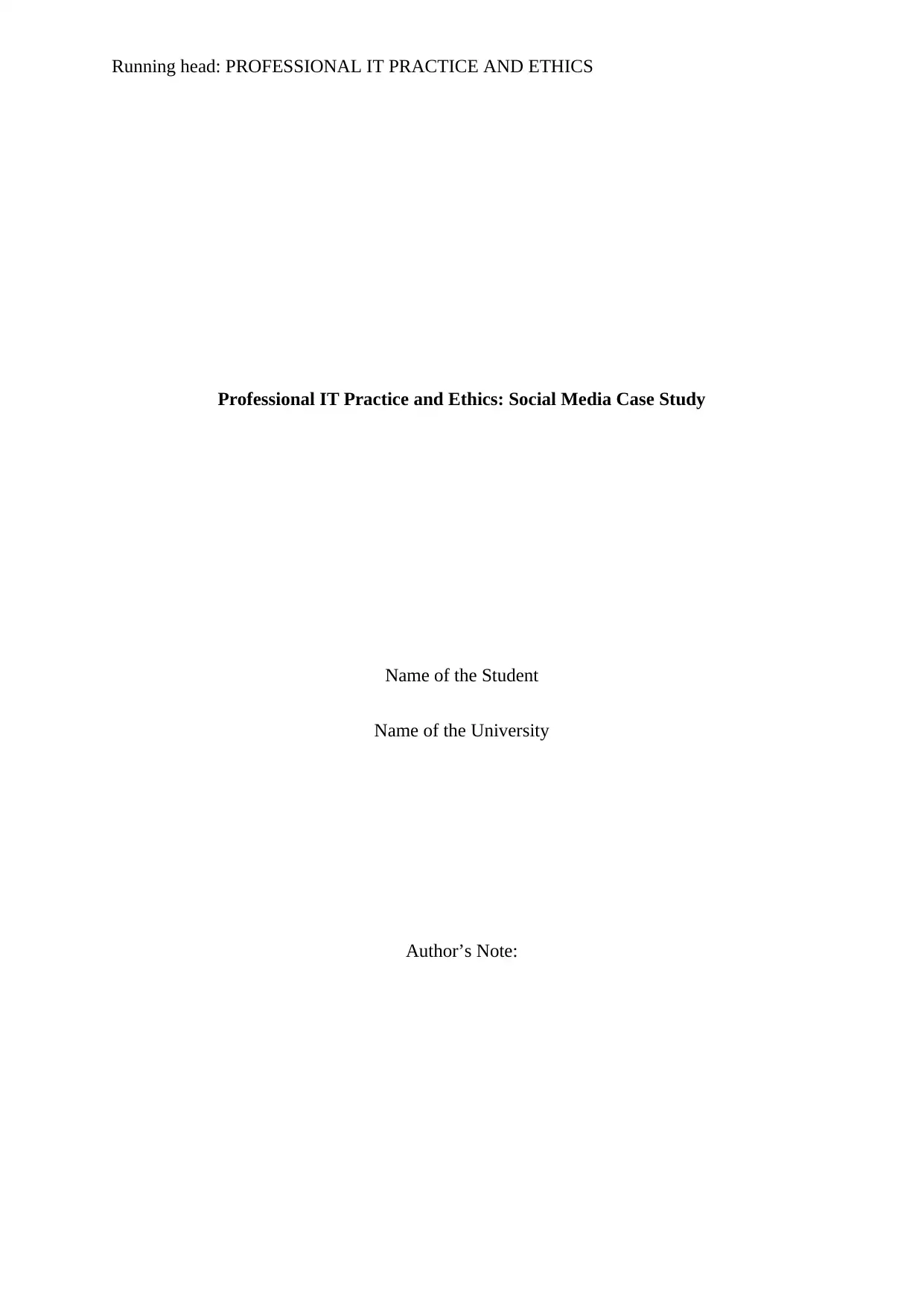
Running head: PROFESSIONAL IT PRACTICE AND ETHICS
Professional IT Practice and Ethics: Social Media Case Study
Name of the Student
Name of the University
Author’s Note:
Professional IT Practice and Ethics: Social Media Case Study
Name of the Student
Name of the University
Author’s Note:
Secure Best Marks with AI Grader
Need help grading? Try our AI Grader for instant feedback on your assignments.
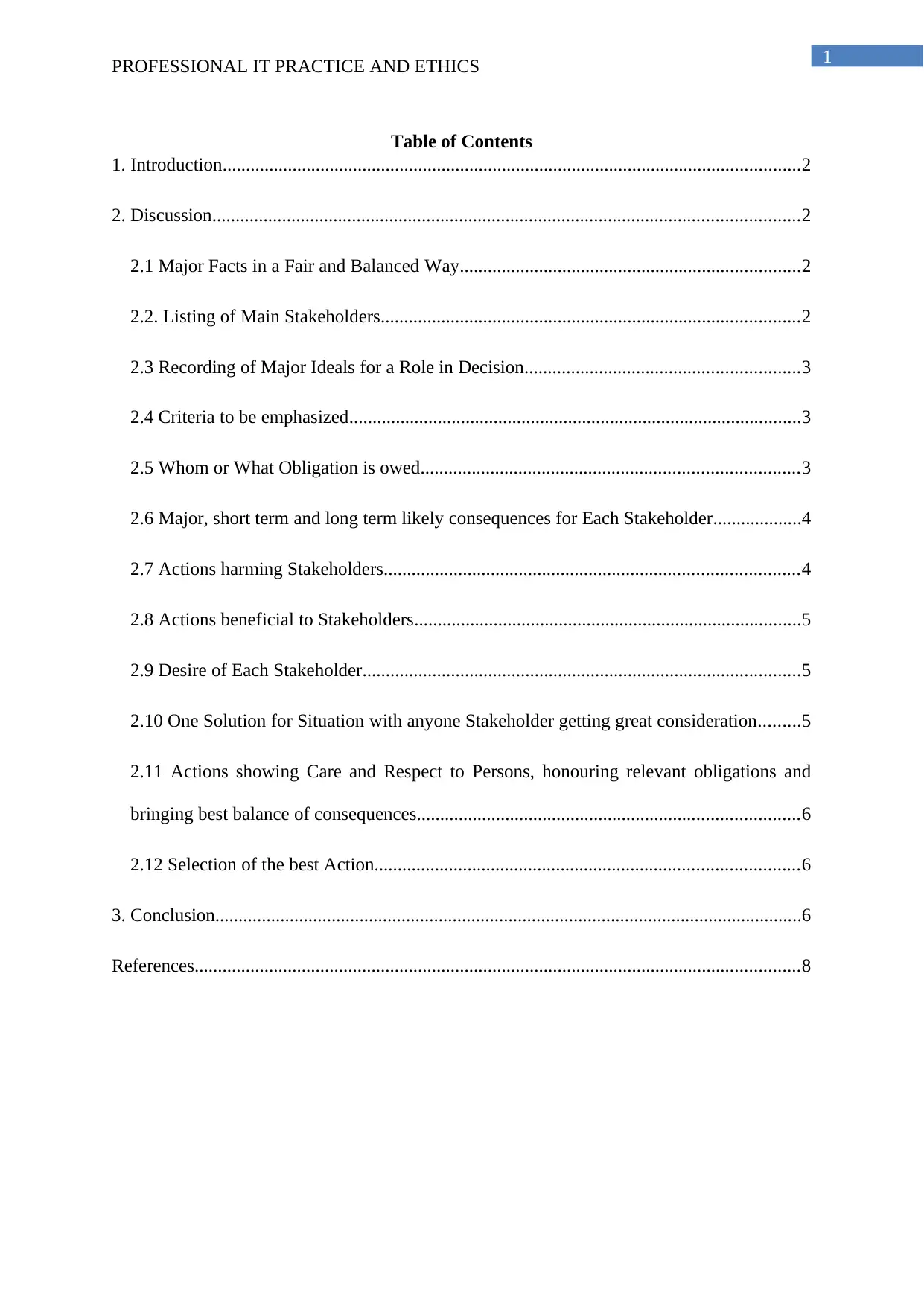
1
PROFESSIONAL IT PRACTICE AND ETHICS
Table of Contents
1. Introduction............................................................................................................................2
2. Discussion..............................................................................................................................2
2.1 Major Facts in a Fair and Balanced Way.........................................................................2
2.2. Listing of Main Stakeholders..........................................................................................2
2.3 Recording of Major Ideals for a Role in Decision...........................................................3
2.4 Criteria to be emphasized.................................................................................................3
2.5 Whom or What Obligation is owed.................................................................................3
2.6 Major, short term and long term likely consequences for Each Stakeholder...................4
2.7 Actions harming Stakeholders.........................................................................................4
2.8 Actions beneficial to Stakeholders...................................................................................5
2.9 Desire of Each Stakeholder..............................................................................................5
2.10 One Solution for Situation with anyone Stakeholder getting great consideration.........5
2.11 Actions showing Care and Respect to Persons, honouring relevant obligations and
bringing best balance of consequences..................................................................................6
2.12 Selection of the best Action...........................................................................................6
3. Conclusion..............................................................................................................................6
References..................................................................................................................................8
PROFESSIONAL IT PRACTICE AND ETHICS
Table of Contents
1. Introduction............................................................................................................................2
2. Discussion..............................................................................................................................2
2.1 Major Facts in a Fair and Balanced Way.........................................................................2
2.2. Listing of Main Stakeholders..........................................................................................2
2.3 Recording of Major Ideals for a Role in Decision...........................................................3
2.4 Criteria to be emphasized.................................................................................................3
2.5 Whom or What Obligation is owed.................................................................................3
2.6 Major, short term and long term likely consequences for Each Stakeholder...................4
2.7 Actions harming Stakeholders.........................................................................................4
2.8 Actions beneficial to Stakeholders...................................................................................5
2.9 Desire of Each Stakeholder..............................................................................................5
2.10 One Solution for Situation with anyone Stakeholder getting great consideration.........5
2.11 Actions showing Care and Respect to Persons, honouring relevant obligations and
bringing best balance of consequences..................................................................................6
2.12 Selection of the best Action...........................................................................................6
3. Conclusion..............................................................................................................................6
References..................................................................................................................................8
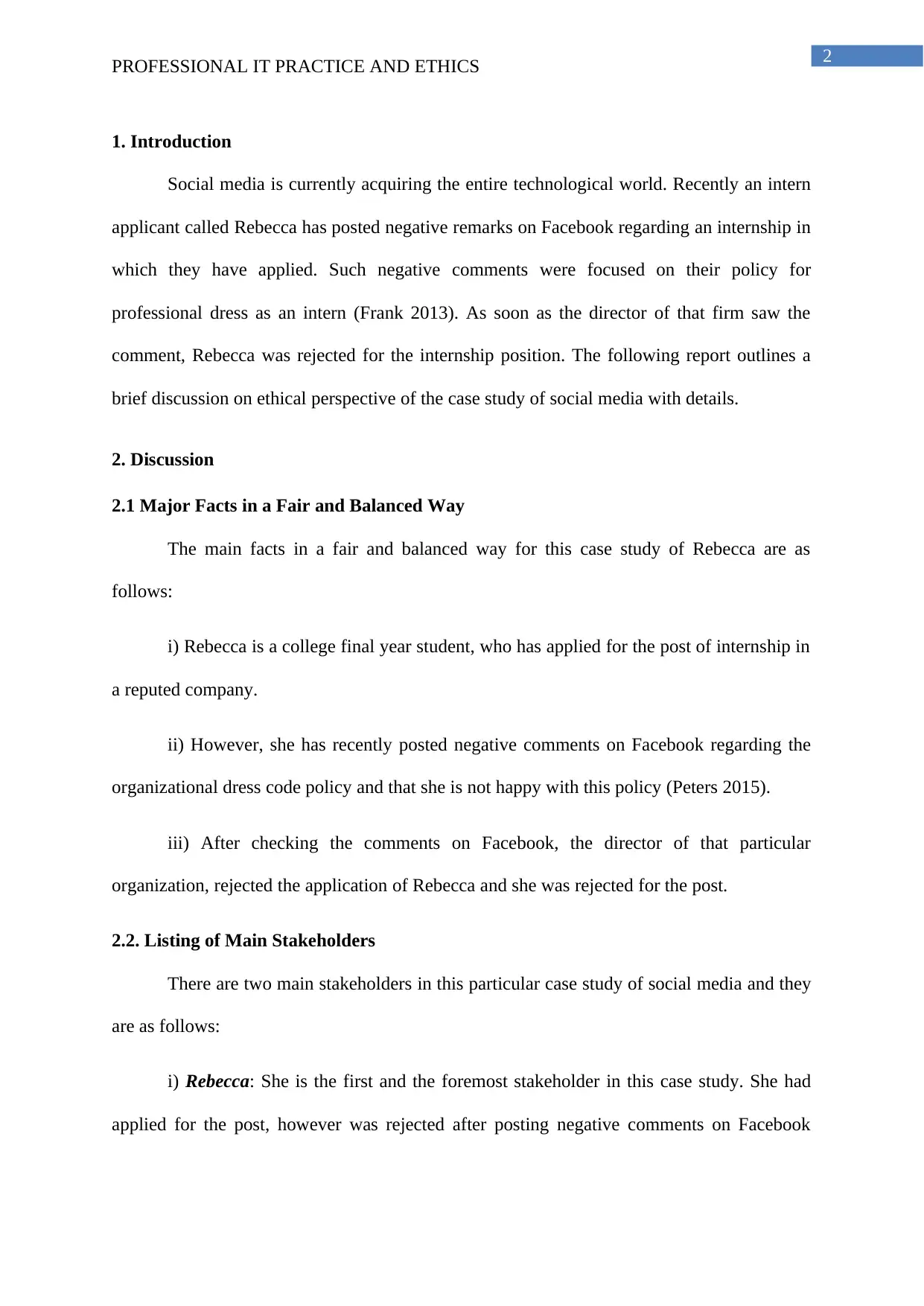
2
PROFESSIONAL IT PRACTICE AND ETHICS
1. Introduction
Social media is currently acquiring the entire technological world. Recently an intern
applicant called Rebecca has posted negative remarks on Facebook regarding an internship in
which they have applied. Such negative comments were focused on their policy for
professional dress as an intern (Frank 2013). As soon as the director of that firm saw the
comment, Rebecca was rejected for the internship position. The following report outlines a
brief discussion on ethical perspective of the case study of social media with details.
2. Discussion
2.1 Major Facts in a Fair and Balanced Way
The main facts in a fair and balanced way for this case study of Rebecca are as
follows:
i) Rebecca is a college final year student, who has applied for the post of internship in
a reputed company.
ii) However, she has recently posted negative comments on Facebook regarding the
organizational dress code policy and that she is not happy with this policy (Peters 2015).
iii) After checking the comments on Facebook, the director of that particular
organization, rejected the application of Rebecca and she was rejected for the post.
2.2. Listing of Main Stakeholders
There are two main stakeholders in this particular case study of social media and they
are as follows:
i) Rebecca: She is the first and the foremost stakeholder in this case study. She had
applied for the post, however was rejected after posting negative comments on Facebook
PROFESSIONAL IT PRACTICE AND ETHICS
1. Introduction
Social media is currently acquiring the entire technological world. Recently an intern
applicant called Rebecca has posted negative remarks on Facebook regarding an internship in
which they have applied. Such negative comments were focused on their policy for
professional dress as an intern (Frank 2013). As soon as the director of that firm saw the
comment, Rebecca was rejected for the internship position. The following report outlines a
brief discussion on ethical perspective of the case study of social media with details.
2. Discussion
2.1 Major Facts in a Fair and Balanced Way
The main facts in a fair and balanced way for this case study of Rebecca are as
follows:
i) Rebecca is a college final year student, who has applied for the post of internship in
a reputed company.
ii) However, she has recently posted negative comments on Facebook regarding the
organizational dress code policy and that she is not happy with this policy (Peters 2015).
iii) After checking the comments on Facebook, the director of that particular
organization, rejected the application of Rebecca and she was rejected for the post.
2.2. Listing of Main Stakeholders
There are two main stakeholders in this particular case study of social media and they
are as follows:
i) Rebecca: She is the first and the foremost stakeholder in this case study. She had
applied for the post, however was rejected after posting negative comments on Facebook
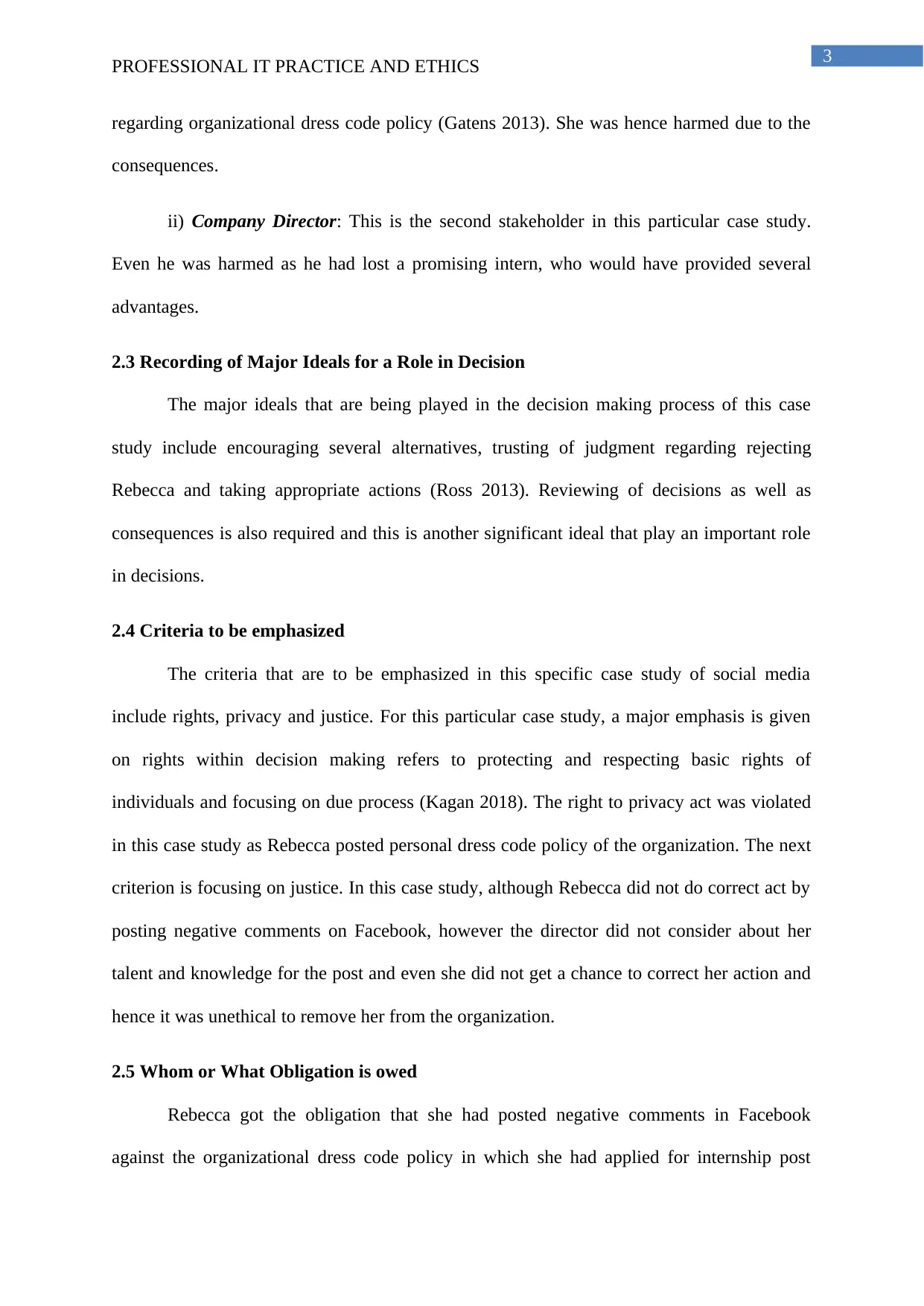
3
PROFESSIONAL IT PRACTICE AND ETHICS
regarding organizational dress code policy (Gatens 2013). She was hence harmed due to the
consequences.
ii) Company Director: This is the second stakeholder in this particular case study.
Even he was harmed as he had lost a promising intern, who would have provided several
advantages.
2.3 Recording of Major Ideals for a Role in Decision
The major ideals that are being played in the decision making process of this case
study include encouraging several alternatives, trusting of judgment regarding rejecting
Rebecca and taking appropriate actions (Ross 2013). Reviewing of decisions as well as
consequences is also required and this is another significant ideal that play an important role
in decisions.
2.4 Criteria to be emphasized
The criteria that are to be emphasized in this specific case study of social media
include rights, privacy and justice. For this particular case study, a major emphasis is given
on rights within decision making refers to protecting and respecting basic rights of
individuals and focusing on due process (Kagan 2018). The right to privacy act was violated
in this case study as Rebecca posted personal dress code policy of the organization. The next
criterion is focusing on justice. In this case study, although Rebecca did not do correct act by
posting negative comments on Facebook, however the director did not consider about her
talent and knowledge for the post and even she did not get a chance to correct her action and
hence it was unethical to remove her from the organization.
2.5 Whom or What Obligation is owed
Rebecca got the obligation that she had posted negative comments in Facebook
against the organizational dress code policy in which she had applied for internship post
PROFESSIONAL IT PRACTICE AND ETHICS
regarding organizational dress code policy (Gatens 2013). She was hence harmed due to the
consequences.
ii) Company Director: This is the second stakeholder in this particular case study.
Even he was harmed as he had lost a promising intern, who would have provided several
advantages.
2.3 Recording of Major Ideals for a Role in Decision
The major ideals that are being played in the decision making process of this case
study include encouraging several alternatives, trusting of judgment regarding rejecting
Rebecca and taking appropriate actions (Ross 2013). Reviewing of decisions as well as
consequences is also required and this is another significant ideal that play an important role
in decisions.
2.4 Criteria to be emphasized
The criteria that are to be emphasized in this specific case study of social media
include rights, privacy and justice. For this particular case study, a major emphasis is given
on rights within decision making refers to protecting and respecting basic rights of
individuals and focusing on due process (Kagan 2018). The right to privacy act was violated
in this case study as Rebecca posted personal dress code policy of the organization. The next
criterion is focusing on justice. In this case study, although Rebecca did not do correct act by
posting negative comments on Facebook, however the director did not consider about her
talent and knowledge for the post and even she did not get a chance to correct her action and
hence it was unethical to remove her from the organization.
2.5 Whom or What Obligation is owed
Rebecca got the obligation that she had posted negative comments in Facebook
against the organizational dress code policy in which she had applied for internship post
Secure Best Marks with AI Grader
Need help grading? Try our AI Grader for instant feedback on your assignments.
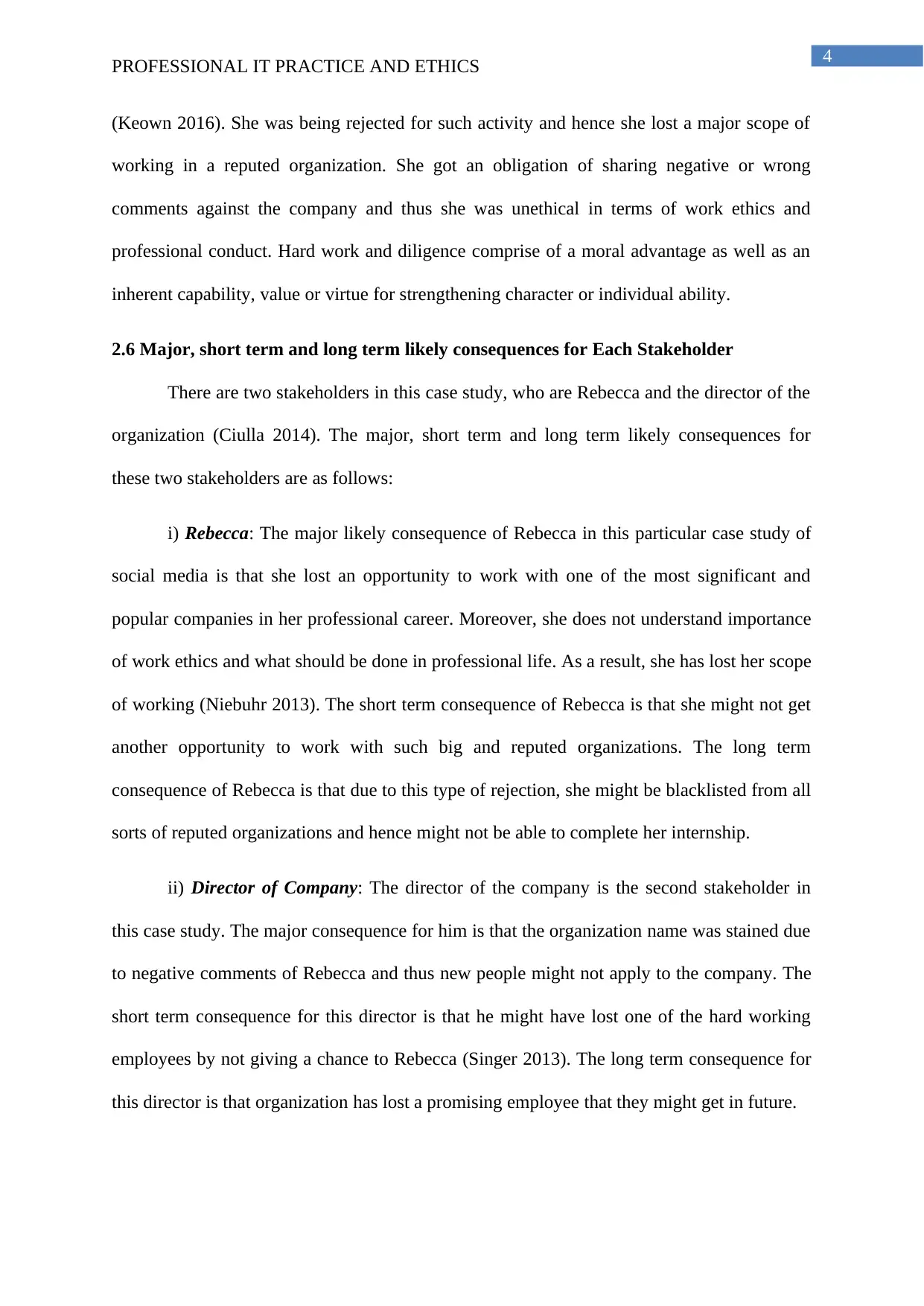
4
PROFESSIONAL IT PRACTICE AND ETHICS
(Keown 2016). She was being rejected for such activity and hence she lost a major scope of
working in a reputed organization. She got an obligation of sharing negative or wrong
comments against the company and thus she was unethical in terms of work ethics and
professional conduct. Hard work and diligence comprise of a moral advantage as well as an
inherent capability, value or virtue for strengthening character or individual ability.
2.6 Major, short term and long term likely consequences for Each Stakeholder
There are two stakeholders in this case study, who are Rebecca and the director of the
organization (Ciulla 2014). The major, short term and long term likely consequences for
these two stakeholders are as follows:
i) Rebecca: The major likely consequence of Rebecca in this particular case study of
social media is that she lost an opportunity to work with one of the most significant and
popular companies in her professional career. Moreover, she does not understand importance
of work ethics and what should be done in professional life. As a result, she has lost her scope
of working (Niebuhr 2013). The short term consequence of Rebecca is that she might not get
another opportunity to work with such big and reputed organizations. The long term
consequence of Rebecca is that due to this type of rejection, she might be blacklisted from all
sorts of reputed organizations and hence might not be able to complete her internship.
ii) Director of Company: The director of the company is the second stakeholder in
this case study. The major consequence for him is that the organization name was stained due
to negative comments of Rebecca and thus new people might not apply to the company. The
short term consequence for this director is that he might have lost one of the hard working
employees by not giving a chance to Rebecca (Singer 2013). The long term consequence for
this director is that organization has lost a promising employee that they might get in future.
PROFESSIONAL IT PRACTICE AND ETHICS
(Keown 2016). She was being rejected for such activity and hence she lost a major scope of
working in a reputed organization. She got an obligation of sharing negative or wrong
comments against the company and thus she was unethical in terms of work ethics and
professional conduct. Hard work and diligence comprise of a moral advantage as well as an
inherent capability, value or virtue for strengthening character or individual ability.
2.6 Major, short term and long term likely consequences for Each Stakeholder
There are two stakeholders in this case study, who are Rebecca and the director of the
organization (Ciulla 2014). The major, short term and long term likely consequences for
these two stakeholders are as follows:
i) Rebecca: The major likely consequence of Rebecca in this particular case study of
social media is that she lost an opportunity to work with one of the most significant and
popular companies in her professional career. Moreover, she does not understand importance
of work ethics and what should be done in professional life. As a result, she has lost her scope
of working (Niebuhr 2013). The short term consequence of Rebecca is that she might not get
another opportunity to work with such big and reputed organizations. The long term
consequence of Rebecca is that due to this type of rejection, she might be blacklisted from all
sorts of reputed organizations and hence might not be able to complete her internship.
ii) Director of Company: The director of the company is the second stakeholder in
this case study. The major consequence for him is that the organization name was stained due
to negative comments of Rebecca and thus new people might not apply to the company. The
short term consequence for this director is that he might have lost one of the hard working
employees by not giving a chance to Rebecca (Singer 2013). The long term consequence for
this director is that organization has lost a promising employee that they might get in future.
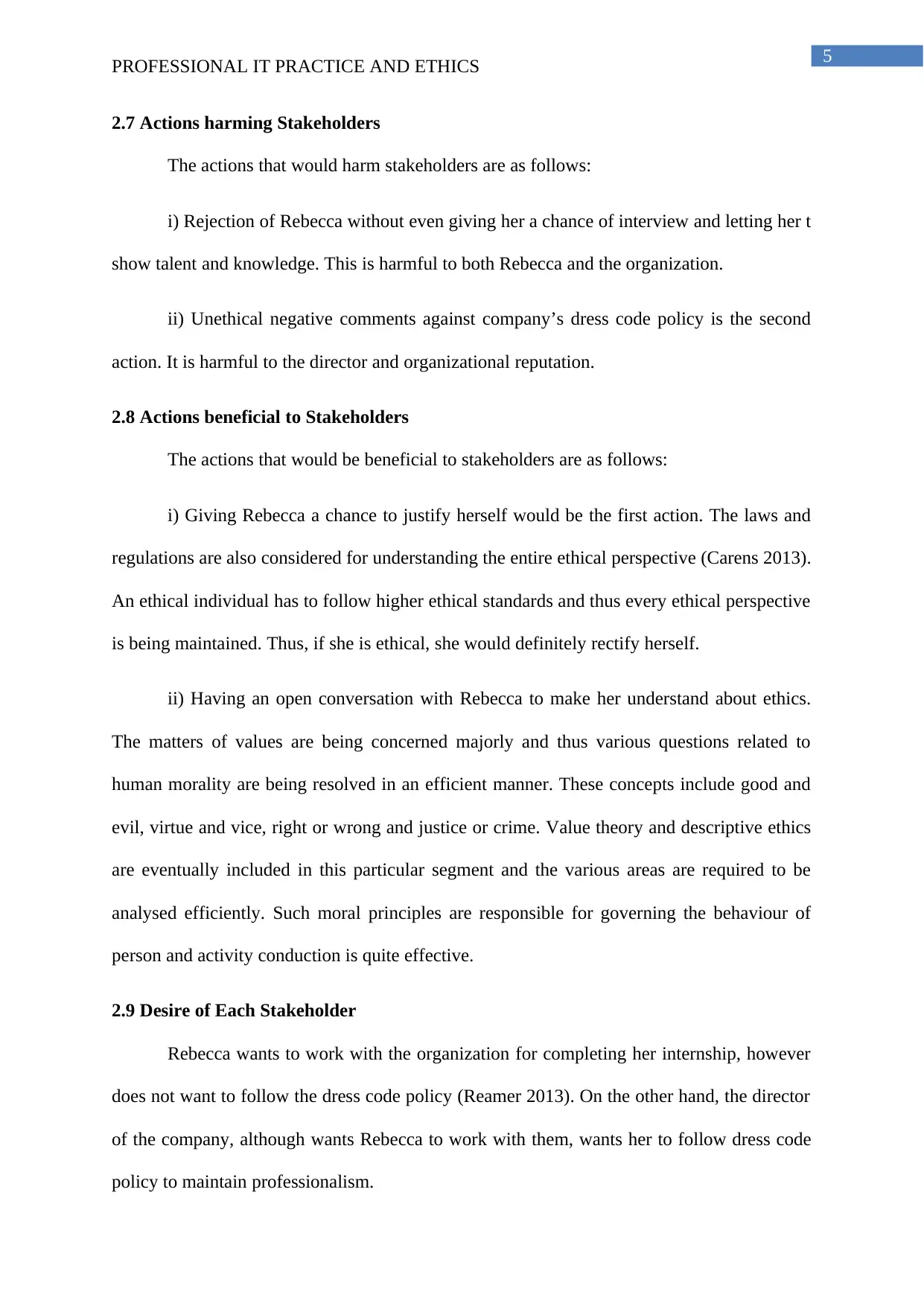
5
PROFESSIONAL IT PRACTICE AND ETHICS
2.7 Actions harming Stakeholders
The actions that would harm stakeholders are as follows:
i) Rejection of Rebecca without even giving her a chance of interview and letting her t
show talent and knowledge. This is harmful to both Rebecca and the organization.
ii) Unethical negative comments against company’s dress code policy is the second
action. It is harmful to the director and organizational reputation.
2.8 Actions beneficial to Stakeholders
The actions that would be beneficial to stakeholders are as follows:
i) Giving Rebecca a chance to justify herself would be the first action. The laws and
regulations are also considered for understanding the entire ethical perspective (Carens 2013).
An ethical individual has to follow higher ethical standards and thus every ethical perspective
is being maintained. Thus, if she is ethical, she would definitely rectify herself.
ii) Having an open conversation with Rebecca to make her understand about ethics.
The matters of values are being concerned majorly and thus various questions related to
human morality are being resolved in an efficient manner. These concepts include good and
evil, virtue and vice, right or wrong and justice or crime. Value theory and descriptive ethics
are eventually included in this particular segment and the various areas are required to be
analysed efficiently. Such moral principles are responsible for governing the behaviour of
person and activity conduction is quite effective.
2.9 Desire of Each Stakeholder
Rebecca wants to work with the organization for completing her internship, however
does not want to follow the dress code policy (Reamer 2013). On the other hand, the director
of the company, although wants Rebecca to work with them, wants her to follow dress code
policy to maintain professionalism.
PROFESSIONAL IT PRACTICE AND ETHICS
2.7 Actions harming Stakeholders
The actions that would harm stakeholders are as follows:
i) Rejection of Rebecca without even giving her a chance of interview and letting her t
show talent and knowledge. This is harmful to both Rebecca and the organization.
ii) Unethical negative comments against company’s dress code policy is the second
action. It is harmful to the director and organizational reputation.
2.8 Actions beneficial to Stakeholders
The actions that would be beneficial to stakeholders are as follows:
i) Giving Rebecca a chance to justify herself would be the first action. The laws and
regulations are also considered for understanding the entire ethical perspective (Carens 2013).
An ethical individual has to follow higher ethical standards and thus every ethical perspective
is being maintained. Thus, if she is ethical, she would definitely rectify herself.
ii) Having an open conversation with Rebecca to make her understand about ethics.
The matters of values are being concerned majorly and thus various questions related to
human morality are being resolved in an efficient manner. These concepts include good and
evil, virtue and vice, right or wrong and justice or crime. Value theory and descriptive ethics
are eventually included in this particular segment and the various areas are required to be
analysed efficiently. Such moral principles are responsible for governing the behaviour of
person and activity conduction is quite effective.
2.9 Desire of Each Stakeholder
Rebecca wants to work with the organization for completing her internship, however
does not want to follow the dress code policy (Reamer 2013). On the other hand, the director
of the company, although wants Rebecca to work with them, wants her to follow dress code
policy to maintain professionalism.
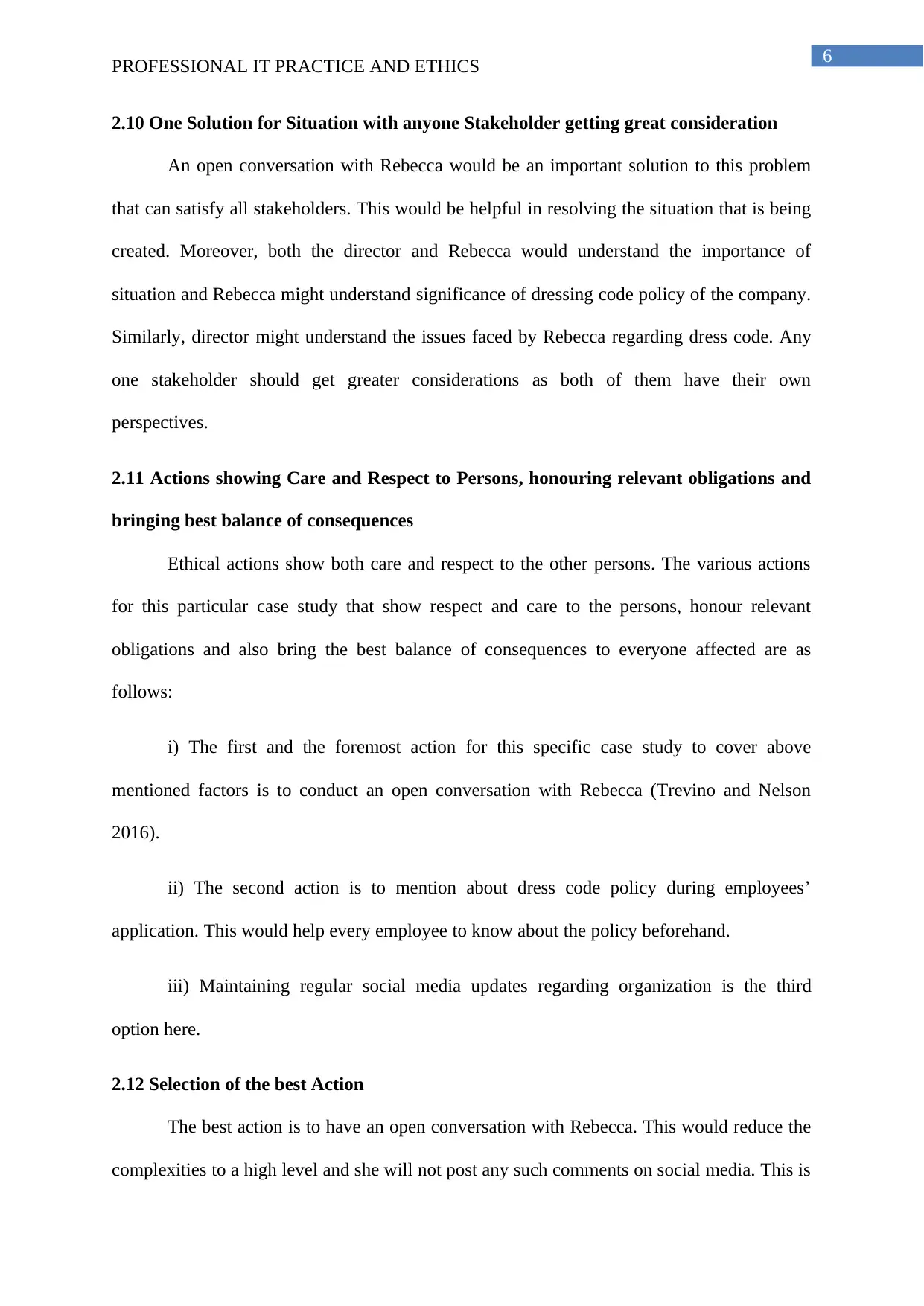
6
PROFESSIONAL IT PRACTICE AND ETHICS
2.10 One Solution for Situation with anyone Stakeholder getting great consideration
An open conversation with Rebecca would be an important solution to this problem
that can satisfy all stakeholders. This would be helpful in resolving the situation that is being
created. Moreover, both the director and Rebecca would understand the importance of
situation and Rebecca might understand significance of dressing code policy of the company.
Similarly, director might understand the issues faced by Rebecca regarding dress code. Any
one stakeholder should get greater considerations as both of them have their own
perspectives.
2.11 Actions showing Care and Respect to Persons, honouring relevant obligations and
bringing best balance of consequences
Ethical actions show both care and respect to the other persons. The various actions
for this particular case study that show respect and care to the persons, honour relevant
obligations and also bring the best balance of consequences to everyone affected are as
follows:
i) The first and the foremost action for this specific case study to cover above
mentioned factors is to conduct an open conversation with Rebecca (Trevino and Nelson
2016).
ii) The second action is to mention about dress code policy during employees’
application. This would help every employee to know about the policy beforehand.
iii) Maintaining regular social media updates regarding organization is the third
option here.
2.12 Selection of the best Action
The best action is to have an open conversation with Rebecca. This would reduce the
complexities to a high level and she will not post any such comments on social media. This is
PROFESSIONAL IT PRACTICE AND ETHICS
2.10 One Solution for Situation with anyone Stakeholder getting great consideration
An open conversation with Rebecca would be an important solution to this problem
that can satisfy all stakeholders. This would be helpful in resolving the situation that is being
created. Moreover, both the director and Rebecca would understand the importance of
situation and Rebecca might understand significance of dressing code policy of the company.
Similarly, director might understand the issues faced by Rebecca regarding dress code. Any
one stakeholder should get greater considerations as both of them have their own
perspectives.
2.11 Actions showing Care and Respect to Persons, honouring relevant obligations and
bringing best balance of consequences
Ethical actions show both care and respect to the other persons. The various actions
for this particular case study that show respect and care to the persons, honour relevant
obligations and also bring the best balance of consequences to everyone affected are as
follows:
i) The first and the foremost action for this specific case study to cover above
mentioned factors is to conduct an open conversation with Rebecca (Trevino and Nelson
2016).
ii) The second action is to mention about dress code policy during employees’
application. This would help every employee to know about the policy beforehand.
iii) Maintaining regular social media updates regarding organization is the third
option here.
2.12 Selection of the best Action
The best action is to have an open conversation with Rebecca. This would reduce the
complexities to a high level and she will not post any such comments on social media. This is
Paraphrase This Document
Need a fresh take? Get an instant paraphrase of this document with our AI Paraphraser
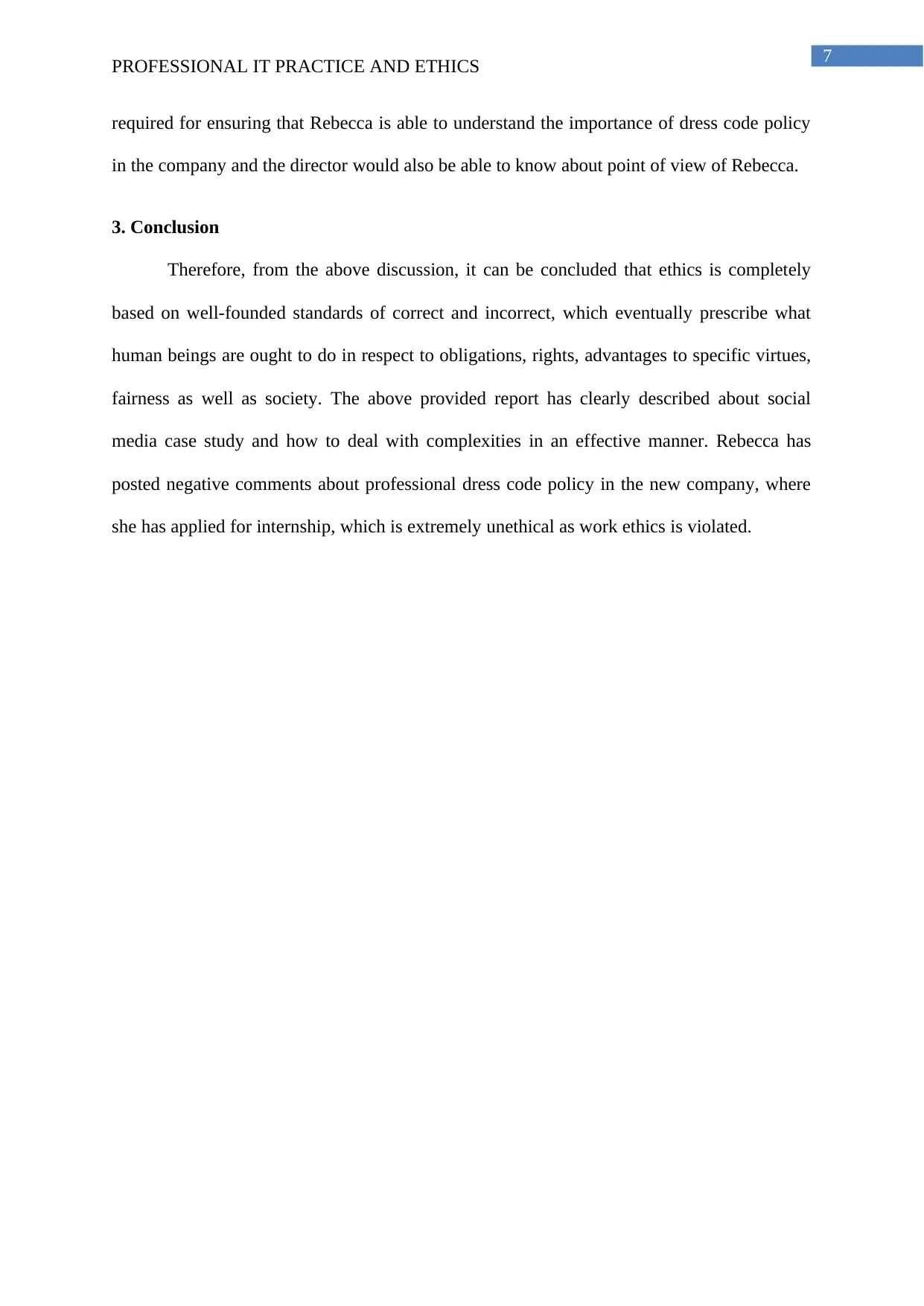
7
PROFESSIONAL IT PRACTICE AND ETHICS
required for ensuring that Rebecca is able to understand the importance of dress code policy
in the company and the director would also be able to know about point of view of Rebecca.
3. Conclusion
Therefore, from the above discussion, it can be concluded that ethics is completely
based on well-founded standards of correct and incorrect, which eventually prescribe what
human beings are ought to do in respect to obligations, rights, advantages to specific virtues,
fairness as well as society. The above provided report has clearly described about social
media case study and how to deal with complexities in an effective manner. Rebecca has
posted negative comments about professional dress code policy in the new company, where
she has applied for internship, which is extremely unethical as work ethics is violated.
PROFESSIONAL IT PRACTICE AND ETHICS
required for ensuring that Rebecca is able to understand the importance of dress code policy
in the company and the director would also be able to know about point of view of Rebecca.
3. Conclusion
Therefore, from the above discussion, it can be concluded that ethics is completely
based on well-founded standards of correct and incorrect, which eventually prescribe what
human beings are ought to do in respect to obligations, rights, advantages to specific virtues,
fairness as well as society. The above provided report has clearly described about social
media case study and how to deal with complexities in an effective manner. Rebecca has
posted negative comments about professional dress code policy in the new company, where
she has applied for internship, which is extremely unethical as work ethics is violated.
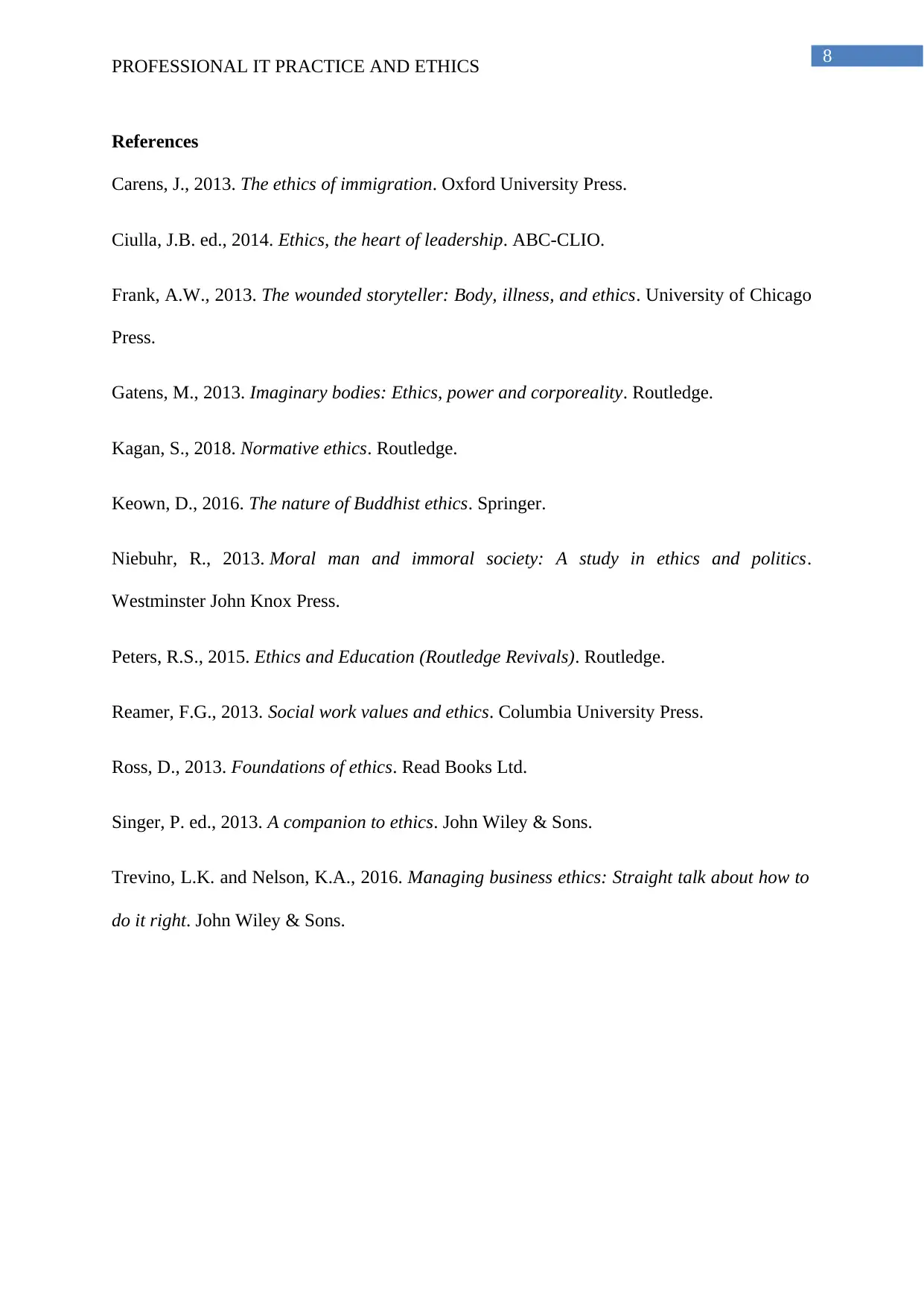
8
PROFESSIONAL IT PRACTICE AND ETHICS
References
Carens, J., 2013. The ethics of immigration. Oxford University Press.
Ciulla, J.B. ed., 2014. Ethics, the heart of leadership. ABC-CLIO.
Frank, A.W., 2013. The wounded storyteller: Body, illness, and ethics. University of Chicago
Press.
Gatens, M., 2013. Imaginary bodies: Ethics, power and corporeality. Routledge.
Kagan, S., 2018. Normative ethics. Routledge.
Keown, D., 2016. The nature of Buddhist ethics. Springer.
Niebuhr, R., 2013. Moral man and immoral society: A study in ethics and politics.
Westminster John Knox Press.
Peters, R.S., 2015. Ethics and Education (Routledge Revivals). Routledge.
Reamer, F.G., 2013. Social work values and ethics. Columbia University Press.
Ross, D., 2013. Foundations of ethics. Read Books Ltd.
Singer, P. ed., 2013. A companion to ethics. John Wiley & Sons.
Trevino, L.K. and Nelson, K.A., 2016. Managing business ethics: Straight talk about how to
do it right. John Wiley & Sons.
PROFESSIONAL IT PRACTICE AND ETHICS
References
Carens, J., 2013. The ethics of immigration. Oxford University Press.
Ciulla, J.B. ed., 2014. Ethics, the heart of leadership. ABC-CLIO.
Frank, A.W., 2013. The wounded storyteller: Body, illness, and ethics. University of Chicago
Press.
Gatens, M., 2013. Imaginary bodies: Ethics, power and corporeality. Routledge.
Kagan, S., 2018. Normative ethics. Routledge.
Keown, D., 2016. The nature of Buddhist ethics. Springer.
Niebuhr, R., 2013. Moral man and immoral society: A study in ethics and politics.
Westminster John Knox Press.
Peters, R.S., 2015. Ethics and Education (Routledge Revivals). Routledge.
Reamer, F.G., 2013. Social work values and ethics. Columbia University Press.
Ross, D., 2013. Foundations of ethics. Read Books Ltd.
Singer, P. ed., 2013. A companion to ethics. John Wiley & Sons.
Trevino, L.K. and Nelson, K.A., 2016. Managing business ethics: Straight talk about how to
do it right. John Wiley & Sons.
1 out of 9
Related Documents
Your All-in-One AI-Powered Toolkit for Academic Success.
+13062052269
info@desklib.com
Available 24*7 on WhatsApp / Email
![[object Object]](/_next/static/media/star-bottom.7253800d.svg)
Unlock your academic potential
© 2024 | Zucol Services PVT LTD | All rights reserved.




